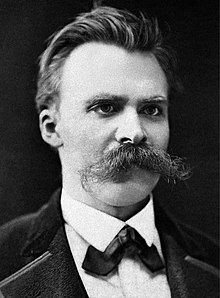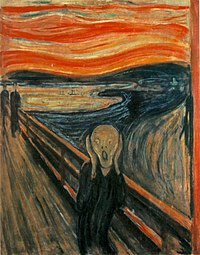Fin de siècle: Difference between revisions
m è |
m bar |
||
| Line 45: | Line 45: | ||
[[Category:French words and phrases]] |
[[Category:French words and phrases]] |
||
[[bar:Fin de siècle]] |
|||
[[ca:Fin de siècle]] |
[[ca:Fin de siècle]] |
||
[[da:Fin de siècle]] |
[[da:Fin de siècle]] |
||
Revision as of 16:29, 28 October 2012
| Fin de siècle |
|---|
 |
Fin de siècle (French pronunciation: [fɛ̃ də sjɛkl]) is French for "end of the century".[1] The term typically encompasses not only the meaning of the similar English idiom "turn of the century", but also both the closing and onset of an era, as it was felt to be a period of degeneration, but at the same time a period of hope for a new beginning.[2] The "spirit" of fin de siècle often refers to the cultural hallmarks that were recognized as prominent in the 1880s and 1890s, including boredom, cynicism, pessimism, and a widespread belief that civilization leads to decadence.[3]
"Fin de siècle" is most commonly associated with French artists, especially the French symbolists, and was affected by the cultural awareness characteristic of France at the end of the 19th century. However, the expression is also used to refer to a European-wide cultural movement.[4] The ideas and concerns of the fin de siècle influenced the decades to follow and played an important role in the birth of modernism.[5]
The themes of "fin de siècle" political culture were very controversial and have been cited as a major influence on fascism.[6][7] The major political theme of the era was that of revolt against materialism, rationalism, positivism, bourgeois society and liberal democracy.[8] The fin-de-siècle generation supported emotionalism, irrationalism, subjectivism and vitalism.[9] The fin-de-siècle mindset saw civilization as being in a crisis that required a massive and total solution.[8]
Fin de siècle culture has been perceived to have influenced 20th century culture, such as Bohemian counterculture having similarities to punk counterculture in that both celebrate a romantic and willful sense of decay.[10]
Basic connotations



The expression fin de siècle usually refers to the end of the 19th century, in Europe, France and/or Paris. It has connotations of decadence, which are seen as typical for the last years of a culturally vibrant period (La Belle Époque at the turn of the 19th to 20th century and until World War I), and of anticipative excitement about, or despair facing, impending change, or both, that is generally expected when a century or time period draws to a close. In Russia, the term Silver Age is somewhat more popular.

That the expression is in French probably comes from the fact that the fin de siècle is particularly associated with certain late 19th-century French-speaking circles in Paris and Brussels, exemplified by artists like Stéphane Mallarmé and Claude Debussy, movements like Symbolism, and in works like Oscar Wilde's Salomé (originally written in French and premiered in Paris)—which connects the idea of the fin de siècle also to the Aesthetic movement. Also, Edvard Munch spent some of his time in Paris around the turn of the 19th to 20th century, which was his most melancholy period.
Broader sense
In a broader sense the expression fin de siècle is used to characterise anything that has an ominous mixture of opulence and/or decadence, combined with a shared prospect of unavoidable radical change or some approaching "end".[citation needed]
The expression fin de siècle implies not change itself, but rather its anticipation. For example, for the 19th-century fin de siècle, the most radical changes to the cultural and social order occurred more than a decade after the 20th century had started (most notably as a result of World War I). The Belle Époque was not even at its height in 1900, nor had the Edwardian era (almost seamlessly following the Victorian era) even started.[citation needed]
See also
References
- ^ "Collection Tate. Glossary Fin de siècle"
- ^ Talia Schaffer (2007). Literature and Culture at the Fin de Siècle. New York: Longman, p.3.
- ^ Stjepan G. Meštrović. The Coming Fin de Siecle: An Application of Durkheim's Sociology to modernity and postmodernism. Oxon, England, UK; New York, New York, USA: Routledge, 1991, 2011. Pp. 1.
- ^ Patrick McGuinness (Ed.)(2000) Symbolism, Decadence and the Fin de Siècle: French and European Perspectives. Exeter: University Press, p. 9.
- ^ J.Trygve Has-Ellison. Nobles, Modernism, and the Culture of fin-de-siècle Munich. In: German History 2008 26(1):1-23, p. 2.
- ^ Sternhell, Zeev, "Crisis of Fin-de-siècle Thought" in Griffin, Roger, ed., International Fascism: Theories, Causes and the New Consensus (London and New York, 1998) p. 169.
- ^ Stanley G. Payne. A history of fascism, 1914-1945. Digital printing edition. Oxon, England, UK: Routledge, 1995, 2005. Pp. 23-24.
- ^ a b Sternhell, Zeev, "Crisis of Fin-de-siècle Thought" in Griffin, Roger, ed., International Fascism: Theories, Causes and the New Consensus (London and New York, 1998) p. 170.
- ^ Stanley G. Payne. A history of fascism, 1914-1945. Digital printing edition. Oxon, England, UK: Routledge, 1995, 2005. Pp. 24.
- ^ David A. Ensminger. Visual Vitriol: The Street Art and Subcultures of the Punk and Hardcore Generation. University Press of Mississippi, 2011. Pp. 85.
- ^ Shearer West. Fin de Siecle: Art and Society in an Age of Uncertainty. Overlook Press.
Further reading
- A reference text regarding the 19th century fin de siècle is Barbara Tuchman's The Proud Tower.
- A reference text regarding the 19th century fin de siècle in Vienna is Carl Schorske's Fin-de-Siècle Vienna.
- Sally Ledger's exploration of women at the fin de siecle. The New Woman: Fiction and feminism at the fin de siecle (1997)
External links
- Occulture in the Fin de Siecle Ashe Journal Special on the Fin de Siecle.
